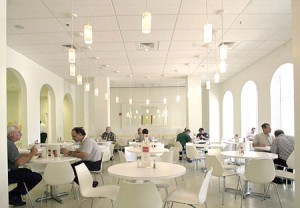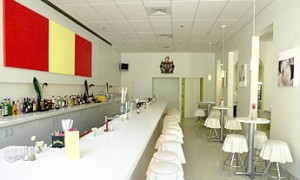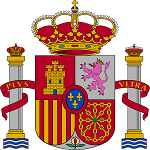 The restaurant moves and gets a modern look that takes its corner of the city from urban same-old to urbane sophistication. The decor sets off the food’s color and warmth.
The restaurant moves and gets a modern look that takes its corner of the city from urban same-old to urbane sophistication. The decor sets off the food’s color and warmth.
By CHRIS SHERMAN, Times Food Critic
Published October 23, 2003
Spain ’s new dining room has white walls, tables, ceilings and lights. It is lit by 20 hanging pendant lamps, and on weekends nights, votive candles are on the banquettes.
The new sparse white decor is punctuated over the bar by a canvas in red and yellow, the colors in the Spanish flag.
For the lunch crowd, it seems a minor change.
They have to walk another 70 steps and around a corner, but then they tuck into plates of boliche, chicken and yellow rice, or freshly flattened Cubans, as they did long before working lunches were eaten over cell phones.
Maybe patrons of Spain Restaurant and Toma are so used to great modern design that a restaurant this sharp is as common as black beans around here. As if.
Calling this place the new Spain doesn’t begin to describe the change, except in the sense of newness that burst out across the Atlantic when the Franco era ended. We haven’t seen a Spanish or Cuban restaurant – actually, almost any restaurant – so smartly designed in decades.
Architect Ken Garcia’s exuberantly modern design is white, white walls, tables, ceilings and lights, but that tone-on-tone doesn’t conceal the sleek shapes of the chairs or the endless arches and columns. And within all that white are bright blocks of red and yellow, the colors in Spain’s flag, over the all-white bar. The view from the street is framed by two flower boxes of green pencil-thin bamboo shoots. A single stalk of red ginger adorns a restroom.
The scene is especially stunning at night, when canvas is drawn over the cafeteria lines for the after-work crowd on weeknights and later diners on weekends. The restaurant is lit by 20 pendant lamps in orbit over the dining room and dozens of votives on the banquettes. You may see it as Bauhaus severity or be delighted that someone skipped cobalt blue for once. Either way you’ll think you’re in another city: Miami? New York? Madrid? Barcelona? It’s that sharp.
 But don’t let the whiteness fool you. It’s more like museum white, there to show off the color and warmth of real food, such as Spanish ham, hot sausage in sherry, Spanish white tuna and sardines, and Spanish omelets on bright blue Talavera ceramics and dark brown clay cazuelas. Add a glass or carafe of modest wine and you have an idea of what tapas is about, a way for city folk or small-town citizens to hang out.
But don’t let the whiteness fool you. It’s more like museum white, there to show off the color and warmth of real food, such as Spanish ham, hot sausage in sherry, Spanish white tuna and sardines, and Spanish omelets on bright blue Talavera ceramics and dark brown clay cazuelas. Add a glass or carafe of modest wine and you have an idea of what tapas is about, a way for city folk or small-town citizens to hang out.
Some tastes are served on crusty bread, as they were when bars first served tapas as a way to keep flies out of the wine (let ’em eat ham). When you can think of a taberna and the contemporary bar space of Toma together, tapas have proved their longevity.
Tapas comes in more forms as well, with the extra flavors of Galicia that the restaurant’s Castro family salutes as much as it does Spain. That rugged region on the northwest coast of Spain, which gave Tampa so many gallego ancestors and a hearty caldo of their soup, is also fond of seafood. So there’s a big tray of of grilled heads-on shrimp in salt and lemon sauce, cold octopus in olive oil and garlic, and mussels in a parsley-green salsa verde.
All are invigoratingly simple, yet I also succumbed to a small dish of scallops done in a cream sauce with manchego cheese. Too rich, my conscience warned, but so what. It’s a small dish, and the scallops were good-sized and not overcooked.
Besides, how can you eat in a Spanish restaurant and not get creamed by bechamel or mayonnaise at least once? If you want more, try seafood crepes.
The only disappointment in seafood was fried calamari, done in a sweet, soggy batter you’d use for hush puppies (and croquetas, too). Paella, even as a $7 tapas, had plenty of seafood; the flaw was the rice – yellow, yet soft and flavorless.
There are meatier tapas, from pork rollitos to hearty classic Spanish tortillas, a rustic omelet of egg potato and onion you can almost eat with your hands. Don’t bite on empanadillas; these little pies seemed to have more fried dough than meat filling.
For entrees, some tapas can be supersized; others range from familiar chicken and yellow rice to weekend specials. They strike the same notes of warmth and tradition you’ll find on the lunch line, where boliche has the tart tang of sour orange.
Such cooking has been in Maria Castro’s family dating to one of New York’s old Spanish favorites, El Faro in Greenwich Village, and she has been feeding downtown Tampa for 25 years.
Spain’s move left a gap in the old quarters on Twiggs, which have been appropriately filled by the Jerk Hut and a new generation of immigrant cooks who fill the steam table with oxtail stew, escovitch and curry.
Meanwhile, Spain has turned the corner into a new century. Slowly Tampa is rounding that bend, too.
A few downtown hipsters and old grand families have already discovered that this brilliantly crisp gallery is the perfect background to show off an urbane future as well as ancient flavors. People, as well as food, look great against the white. The fabled creative class of author Richard Florida meets the Old Florida of Tampa’s ruling class. Encantado.
Certainly, Spain’s the slickest reason to stay downtown after dark in decades.
Spain Restaurant and Toma
513 Tampa St., Tampa
(813) 223-2831 Hours: 7 a.m. to 7 p.m. Monday through Thursday; 7 a.m. to 11 p.m. Friday; 4 to 11 p.m. Saturday.
Reservations: Recommended for large parties.
Details: Full bar, most credit cards, restrooms adapted.
Prices: $3 to $15.


